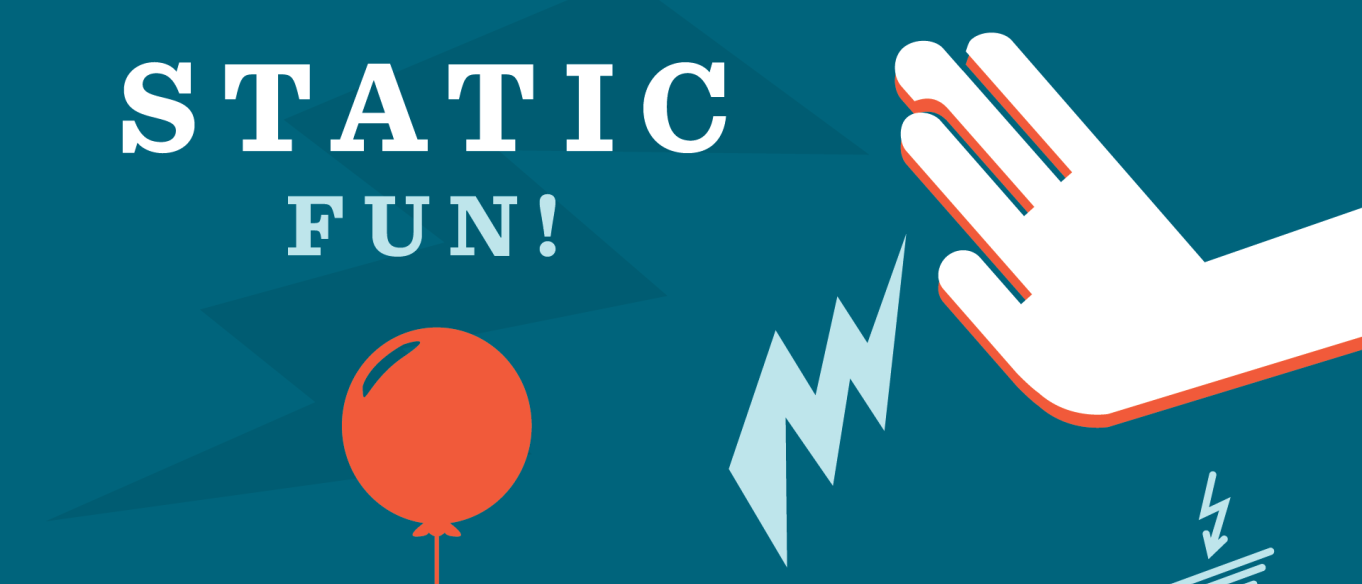
Have you ever rubbed a balloon on your head and made your hair stand up? Have you ever walked across the carpet in your socks and received a shock from a doorknob? These are examples of static electricity. Experiment with static electricity using items found around your house!
Age: 4+
Time: 10 - 30 minutes
Topics: electricity, static, charge, attract, repel
What you need:
- Balloon
- Different types of fabric, such as:
- Felt
- Fleece jacket
- Cotton t-shirt
- One or all of the following:
- Plastic ruler
- Plastic combs
- Pens or markers
- Lightweight objects and materials, such as:
- Styrofoam packing peanuts (not cornstarch ones)
- Empty aluminum cans
- Ping-pong balls
- Tissue paper
- Aluminum foil
- Plastic bags
- String or ribbon
- Confetti or small pieces of paper
- O-shaped cereal
What to do:
See if you can create some static electricity by rubbing various materials together!
1. Using one of the fabric pieces, rub one of the other objects (ruler, comb, pens, or markers) back and forth for several seconds to build up a static charge. Bring the charged object near one of the light-weight materials like balloons or packing peanuts. What do you notice?
2. Try rubbing a different object with the same fabric and test it against the balloon or packing peanuts. Is the result the same? Try different combinations of fabric and object together.
- Do some combinations of fabric and object create a stronger build-up of static charge than others?
- How can you tell?
3. Now test some other lightweight materials. Use whichever fabric and object you decided worked best in Step 2 and build up a static charge on the object. Hold the object close to different lightweight materials (aluminum cans, plastic bag, ping-pong ball, and so on) and observe what happens.
- Which materials are attracted (move toward the charged object) and which are repelled (move away)?
- What do the objects that are attracted have in common?
- What do the objects that are repelled have in common?
4. Draw a chart like the one below on a piece of paper. Use a balloon to create some static electricity by rubbing it with a cloth (or on your hair!) Now experiment with the materials listed in the chart to see how they behave:
- Will they be attracted to the balloon?
- Will they stay stuck to the balloon if you gently move or shake the balloon?
- Does the size or shape of the piece of material you use affect how it behaves?
Make some predictions first, then see how the results compare.
|
Object |
Prediction |
Result |
|
Tissue paper |
|
|
|
Aluminum foil |
|
|
|
Yarn/string |
|
|
|
Packing peanut |
|
|
|
Ribbon |
|
|
|
Confetti |
|
|
|
O-shaped cereal |
|
|
5. Other ideas to try:
- Rub a balloon on your hair to build up a static charge. Can you make the balloon stick to the wall, your shirt, or an unsuspecting grownup’s back?
- Can you move an aluminum can with static electricity? Use a static-charged balloon to move the can across the floor or table without touching it. (Hint: put the can on its side so it can roll!) You could also try the same thing with a ping-pong ball.
- Hang ping-pong balls or cereal O’s from pieces of string. Use a static-charged balloon (or other object) and see if you can make them “dance” on the strings without touching them.
What's happening?
Atoms are really, really small particles that are the building blocks for everything in the universe. Even though atoms are really small, they are made up of other, even smaller particles. One of these types of particles is called a proton, and it has a positive charge; another is called an electron, and it has a negative charge. It is because of these oppositely charged particles that electricity exists. When certain materials are rubbed together, electrons are pulled off of one material and onto the other material. That leaves one material with too many electrons (negatively charged) and the other material with not enough electrons (positively charged). This imbalance of charges is called static electricity. When two materials with the same charges come close together, they repel (push away from) each other. When two materials with opposite charges come together, they attract (pull toward) each other.

